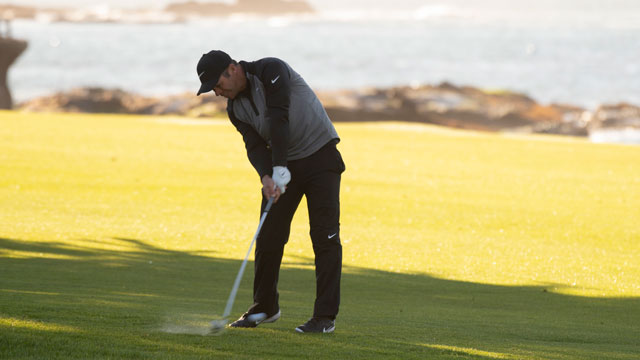NEWS
Coach golfers to consistently find the low point of their swings
By Yong Joo, PGA, with Don Jozwiak, Senior Editor
Published on

Editor's Note: This story originally appeared in the January 2019 edition of PGA Magazine.
PGA Professional Yong Joo, who competed in the 2018 PGA Professional Championship at Bayonet Black Horse in Seaside, California, is the PGA Director of Instruction at Topgolf Loudoun in Ashburn, Virginia.
Most of the students I work with at Topgolf are beginners, whether they’re coming in for individual or group lessons or trying the game as part of a corporate or social event. As beginners, their inclination is to try helping the ball up into the air with an uppercut swing. Of course, this is the opposite of what they need, which is to hit down and make contact with the ball before the club hits the ground.
To cure the chunky and thin shots that come from swinging up on the ball, I work with these beginners on a drill to help them make consistent contact with the ground by controlling the low point of the swing – an improvement that has an immediate, positive impact on their ball-striking, and makes further improvements much easier.
Rehearse Ground Contact WITH Full Swings
Making solid contact is the obvious problem players have when they are hitting up on the ball. They either hit behind the ball and get the heavy shot where the ball doesn’t really do anything but fall short, or they hit a thin shot with a low ball flight that can’t hold a green. I want them to be able to hit down so the leading edge of the club strikes the golf ball first, then hits the ground about an inch past the golf ball.
This starts with a discussion of how golf clubs are designed to make hitting down on the golf ball the best way to get the ball up in the air, since most beginners don’t understand much about the golf swing at this point. This is where I introduce a line drill. I’ll draw a line on the ground about an inch past the golf ball, then have the student set up to the ball in their address position with a short iron.
Then I’ll have them take a small step away from the ball, then take a full practice swing with the intention of hitting the line. I do this with a full swing instead of a partial swing because I find that’s a better rehearsal of intention and helps players repeat the correct motion more quickly.
Make the Most of Your Environment
After working at traditional green grass facilities for most of my career, the last couple of years at Topgolf Loudoun have been a great experience for me. I’ve learned to adapt my coaching style and make full use of the environment and resources here.
For example, I’m teaching on mats instead of grass, so I have to be aware that players can sometimes get away with fat shots – making something like my line drill an even more important lesson to learn. And since the mats don’t bruise the way turf does after a few practice swings, I’ll put some sugar on the mat where I want students to contact the ground so they get visual feedback in the form of a splash of sugar crystals.
I’m also able to use the energy and technology of Topgolf to keep students excited about practicing and improving. I can use all the targets and games built into the Topgolf experience for target-oriented practice.
For example, I can have a student play a round of our signature Topgolf target game before the lesson starts, then have them try again after the lesson using the drill to see if they can beat their previous score. And if they’re really into it and making progress, I can give them some extra time to keep going — and they might bring their family or friends out to show off their progress.
It’s a great way to keep practice fun and build relationships with new golfers.
